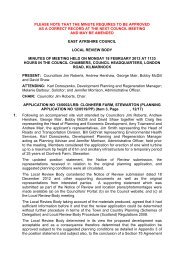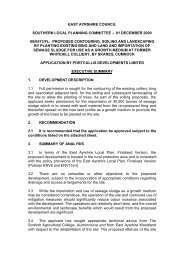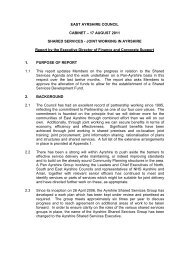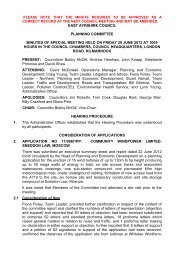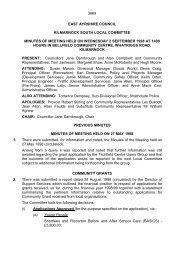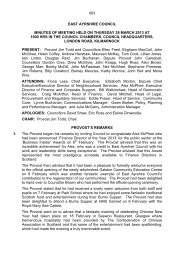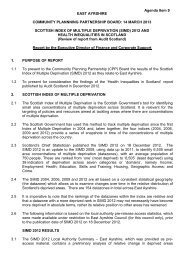Garlaff landfill Site, Skares - Barr Ltd - East Ayrshire Council
Garlaff landfill Site, Skares - Barr Ltd - East Ayrshire Council
Garlaff landfill Site, Skares - Barr Ltd - East Ayrshire Council
Create successful ePaper yourself
Turn your PDF publications into a flip-book with our unique Google optimized e-Paper software.
(ii) The ecological assessment is based on data collected for the EIS for the<br />
<strong>Skares</strong> Road opencast site, which data is interpreted in the context of the current<br />
proposal. In view of the fact that no additional loss of habitat is being incurred,<br />
this approach is reasonable, although it would have been helpful to have included<br />
summary plans illustrating the data being interpreted. Impacts of increased<br />
vermin on local fauna are acknowledged as a key potential impact. An agreed<br />
mitigation programme should include a detailed pest control strategy to<br />
incorporate the elements described including progressive restoration, daily<br />
cover and use of a bird of prey as a scarer.<br />
Implementation of the mitigation measures promoted in the EIS can<br />
be secured through a Section 75 Agreement should consent be<br />
granted for the proposed development.<br />
(iii) Although no additional habitat is proposed in terms of area, the<br />
prolongation of the working lifetime of the site necessarily means a delay in<br />
restoration to habitat suitable for wildlife. Advance restoration of some of the<br />
existing <strong>Garlaff</strong> site as well as the non-operational parts of Area C may serve to<br />
offset this impact to a modest extent. SNH notes the possibility that exposed<br />
cliffs produced as part of the opencast void might present attractive nesting<br />
opportunities to certain bird species, notably peregrine, and in line with the<br />
suggestion in the EIS, an agreed mitigation plan should also include appropriate<br />
monitoring of such areas prior to <strong>landfill</strong> operations that might affect them. The<br />
possibility of future otter use of the Polcalk and Rose Burns is noted. If these are<br />
likely to be affected by the proposed development, works should not proceed<br />
until an acknowledged specialist has carried out a survey of otter use.<br />
The issues raised by SNH can be addressed through the<br />
establishment of a proposed Technical Support Group for the site.<br />
(iv) The original wider <strong>Skares</strong> Road development included as part of the<br />
restoration proposals, a heritage trail that would run around the southern<br />
periphery of the current application site. This is not included on the restoration<br />
master plan and should be included in the final restoration scheme.<br />
The provision of the heritage trail can be addressed through the<br />
establishment of a proposed Technical Support Group for the site<br />
which would assist in developing the restoration strategy and<br />
master plan for the site including final afteruse proposals.<br />
(v) The EIS includes a restoration master plan, illustrating the broad habitat<br />
and landscape features to be created during restoration. It is noted that the EIS<br />
proposes that detailed design proposals be submitted prior to each phase of the<br />
progressive restoration. SNH considers it appropriate for the applicant to draw<br />
up a complete, detailed restoration scheme prior to the commencement of the<br />
<strong>landfill</strong> operations. Such a restoration scheme should illustrate the phased<br />
stages of reclamation/restoration. The restoration scheme should include details<br />
of species used in woodland planting and other features such as wetland areas<br />
and hedgerows. As far as possible, detailed restoration proposals should be set



